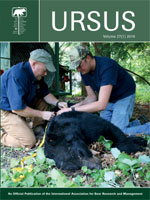Brown bears (Ursus arctos) occasionally engage in geophagy, the act of purposefully ingesting lithogenic mineral substances. From 1999 to 2013, we collected samples from 4,619 brown bear scats from 3 regions of the Russian Far East (Kamchatka, Primorsky Krai, Sakhalin) in order to better understand geophagy in this species. Depending on region collected, soils were detected in 1–5.2% of samples. The greatest soil concentrations were found in scats from Sakhalin in August and September, the same months when Pacific salmon (Oncorhynchus spp.) play a dominant role in seasonal brown bear diets there. Of the 207 Sakhalin scats with soil content, nearly all (87%) also contained fish remains. A chemical analysis of samples suggested that the soils being purposefully consumed by brown bears are clay-like substances from the illuviated soil horizon—minerals that most likely aid the bears in preventing diarrhea by helping excrete excessive amounts of phosphorus inherent in a fish-heavy diet.
How to translate text using browser tools
1 May 2016
Geophagy by brown bears in the Russian Far East
Ivan V. Seryodkin,
Alexander M. Panichev,
Jonathan C. Slaght
ACCESS THE FULL ARTICLE

Ursus
Vol. 27 • No. 1
May 2016
Vol. 27 • No. 1
May 2016
brown bear
clay
geophagy
KAMCHATKA
kudur
Oncorhynchus spp.
Primorsky Krai




